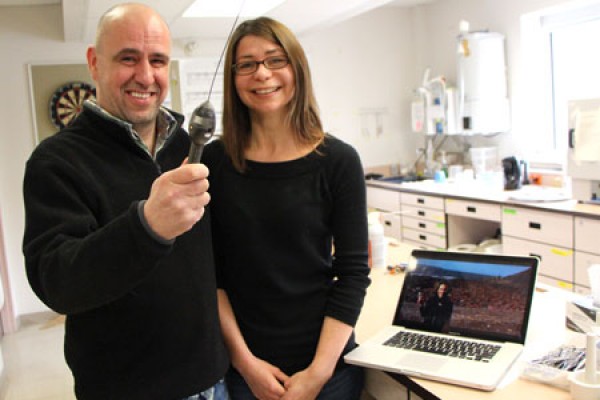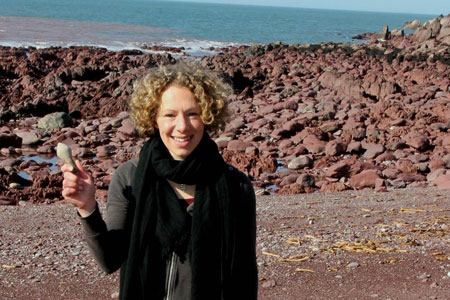 Nigel Hussey, shown here with his wife Anna, holds up a satellite tag like the one he attached to a Greenland shark in the Canadian Arctic. The device detached and floated all the way to Wales, where it was found by Mari Williams.
Nigel Hussey, shown here with his wife Anna, holds up a satellite tag like the one he attached to a Greenland shark in the Canadian Arctic. The device detached and floated all the way to Wales, where it was found by Mari Williams.
Call it a high-tech message in a bottle.
A satellite tagging device used to record migratory data that was attached to a Greenland shark in the Canadian Arctic in 2012 was recently found washed up on a beach in southwest Wales—just a short distance away from the spot where the wife of the researcher who planted it used to spend her summers.
“It’s really fantastic,” said Nigel Hussey, a scientist in the Great Lakes Institute for Environmental Research. “We never would have thought that after putting it out in such a remote place that it ever would have been found.”
A research associate in the lab of professor Aaron Fisk, Dr. Hussey - whose research is partly funded by the Ocean Tracking Network - studies the ecology of a variety of sharks and rays. A common method involves catching sharks and attaching satellite tags to them. Similar in size and shape to a microphone, the device remains on the animals for months at a time, recording a variety of data such as location, water depths and temperatures.
After a certain time, the devices are programmed to release from the animal, float to the surface and transmit the data to a satellite, which the scientists can access from their labs and get a more complete picture of the animal’s behaviour. However, not all the data is transmitted, so getting one back can be a potential gold mine, but extremely rare, Hussey said.
“We’ve never got one back before,” said Hussey, who has planted numerous tags in sharks and rays off the coast of Sudan as well as in the Canadian Arctic. “This tag never transmitted any data to the satellite,” he added, noting that satellite coverage in the remote area can be spotty. “It just seemed to disappear.”
The tag was found March 6 during a beach clean with volunteers on West Dale Bay in Pembrokeshire by Mari Williams, a project officer with an organization called Cadwch Gymru'n Daclus, or Keep Wales Tidy. Coincidentally, Hussey’s wife Anna’s family originates from nearby St. David’s, and that’s where she summered as a teenager.
“I’ve still got an aunt, an uncle and several cousins there,” Anna said. “In fact, Mari knows one of my cousins. They used to work on one of the tourist boats there together.”
Not knowing what the device was, but suspecting it might have been a shark tag, Williams – who has an undergraduate degree in environmental science – posted a picture of the tag on Twitter and tweeted it at the Shark Trust, a shark conservation charity. Simon Pierce, of Marine Megafauna Foundation, recognized the device and recommended she contact Wildlife Computers, the device’s manufacturer. She sent them the serial number, and the Seattle-based company traced it back to Hussey and connected the two.
“I just find the whole thing amazing,” Williams said from her home in Wales.
Based on the data they recovered from the device, Hussey determined it must have come off the animal in December of 2012 in the middle of the Davis Strait, between Baffin Island and Greenland, and floated all the way to Wales – a distance of about 6,000 kilometers.
The device was one of three planted on sharks that were caught by Hussey and his team while working on a government research vessel in September of 2012. It had been programmed to remain on the animal for 340 days, and although it only stayed on for three months, it still contains a wealth of information.
“This is the most detailed data we've ever had for a Greenland shark,” said Hussey.
Watch a video of Hussey releasing a Greenland shark shortly after it was tagged.

Mari Williams sent this photo of herself holding up the satellite tag on the beach where it was found.
